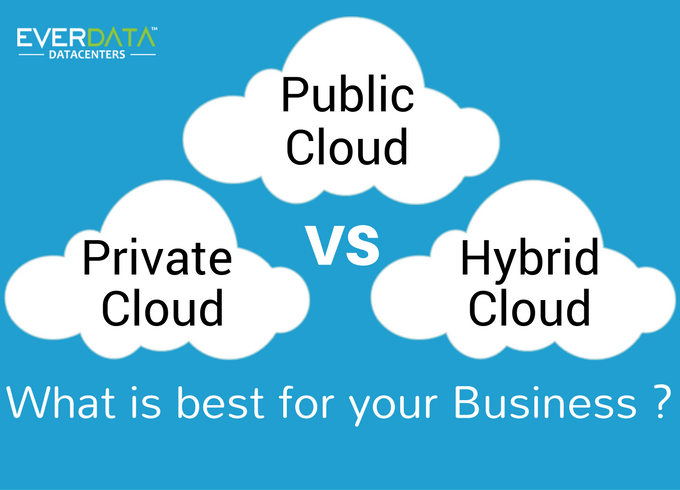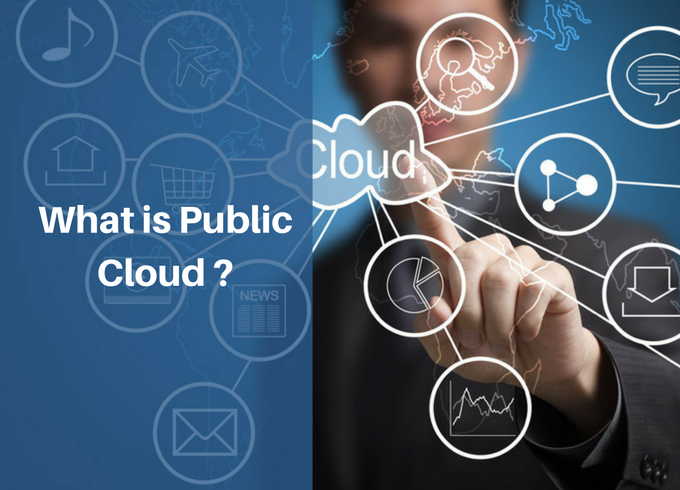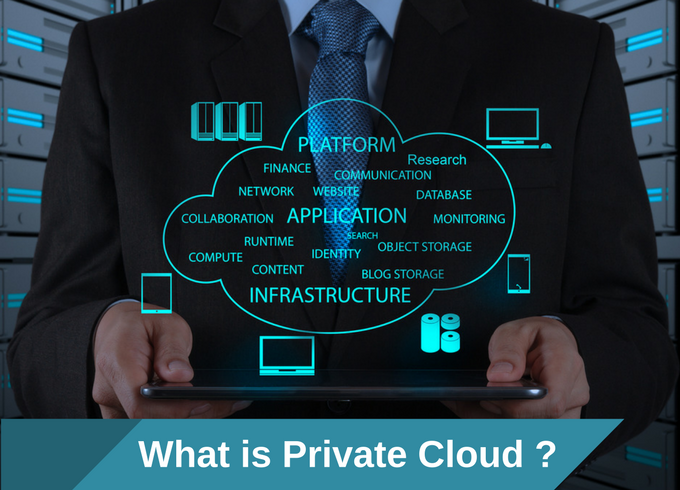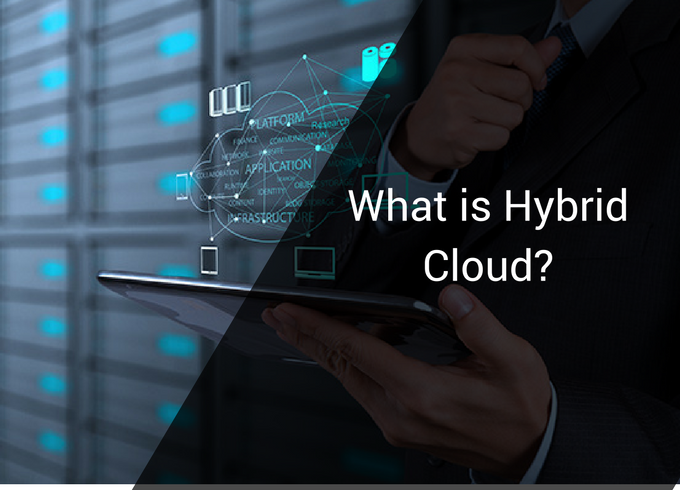
Submitted by Omkar on

These days cloud computing is growing like no other technology. Every business whether it's small, mid-sized or big, wants to use this cutting edge technology for its company.
As cloud technology Becomes extremely favorite among these organizations, but the question arises: Which cloud model to consider for your business? There are three types of cloud models available in the market: Public, Private, and Hybrid.
This article answers all of your questions like which type would be most advantageous for your business.
All the three models are explained and compared with the advantages and pitfalls, thus giving you a crystal clear view, which models you should adopt for your organization.
Basic Cloud Concepts
The concealed idea behind cloud computing originally has the capability to divide resources to enhance the performance by using a variety of networking, computing, and storage resources to process and store data.
Cloud resources can be adaptive and automated: even the smallest change, such as a failing component, can be quickly identified and the workload can be automatically shifted to other working parts.
Types of cloud models differ by control and manageability requirements.
Tip: Have a detailed look at benefits of Managed Cloud Hosting.
Public Cloud
The phrase public cloud is that all services are available over the web, usually on a pay-per-use model.

[Tweet ” The phrase public cloud is that all services are available over the web, usually on a pay-per-use model.”]
The Public Cloud offers excellent levels of efficiency since resources can be shared throughout a network.
Users can enhance their use on demand.
Cloud users are usually residential users and connect to the public internet through an internet service provider�s network.
Data created and submitted by users are stored on the servers of the third-party provider.
Note: Google: Public Clouds Are the Future of Business Recent Report By PCMag
The advantages of public cloud include:
1. Data availability and continuous uptime
2. 24/7 technical expertise
3. On-demand scalability
4. Straightforward and economic setup
5. No wastage of resources
Drawbacks of public cloud
# Data Security and Privacy: It is one of the main issues with the public cloud model. You don’t know that where your data is residing and how it is backed up.
So there is fear of compromising the data by the unauthorized users. Reliability is also an added concern for public cloud networks.
Examples of public cloud vendors who offer their services to the general public:
- Google Cloud Engine
- Salesforce.com
- Amazon AWS
- Microsoft Office 365
Private Cloud
A Private Cloud is an important infrastructure purely dedicated to your business, hosted either on-site or at a service provider data center.

The private cloud delivers agility, scalability and efficiency of the public cloud, but provides higher levels of security and control, making it perfect for larger companies or those with strict data, regulation and governance obligations.
In fact, all cloud models offer the same benefits as there is not much difference in technology.
[Tweet “In fact, all cloud models offer the same benefits as there is not much difference in technology.”]
The Aberdeen group published a report, which concludes that organizations operating private clouds typically have about 12% cost advantage over companies using public clouds.
A private cloud can give the organization greater control over the infrastructure and computational resources.
Advantages Of Private Cloud
# The only notable advantage that private cloud has over the public cloud is that of data security and privacy.
[Tweet “The only notable advantage that private cloud has over the public cloud is that of data security and privacy.”]
# Accessibility to the internal network and increased access/communication for internal users. Over the last several years, major cloud service breaches have dominated the headlines.
Corporations are taking notice, and some are deciding that the private cloud proves less risky. Private cloud’s ability to virtualized services maximizes hardware usage, ultimately reducing costs and complexity.
Drawbacks
# The severe downside of private cloud is its sky-high price.
Note: Cloud Security: The Fundamental Factor in Cloud Computing Universe by CIOReview
When comparisons are made with a public cloud; the cost of purchasing equipment, software and staffing often result in increased costs to an organization with private cloud.
# Highly Qualified IT Staff Needed to manage the Private servers
Hybrid Cloud
Hybrid Clouds are more complicated than the other cloud deployment models because they include a system of more than two clouds (public, or private).

A hybrid cloud is a configuration of at least one private cloud and at least one public cloud.
[Tweet “A hybrid cloud is a configuration of at least one private cloud and at least one public cloud.”]
A hybrid cloud often offers in one of two ways: a public cloud provider forms a partnership with a seller that provides private cloud platforms.
Or a vendor with private cloud does a partnership with a public cloud provider.
In a hybrid cloud, an organization provides and manages some resources in-house and some out-house.
[Tweet “In a hybrid cloud, an organization provides and manages some resources in-house and some out-house.”]
For example, organizations that have their HR (human resource) and CRM (customer relationship management) data in a public cloud like Saleforces.com but have confidential data in their private cloud.
When managed properly, however, a hybrid solution can be rewarding.
Tip:�How the Hybrid Cloud Helps to Transform Enterprise Models.
The benefits of hybrid cloud are:
# Secure and Scalable: Undoubtedly, it is the primary advantage of a hybrid cloud deployment. A perfectly and correctly managed hybrid cloud deployment gives your business the best security and is extremely scalable.
# Cost-effective: Organizations can realize cost-savings by divvying up information to the environment it suits best.
Data that is safe to store in a public environment stays in the public environment, more strictly managed data can remain in the private cloud, and mission-critical applications and data can stay on-premise or in a colocated data center.
# Supplies support for cloud-bursting.
Drawbacks of a hybrid cloud are:
# Inherent inability of supervising several different security platforms
# The privacy and integrity connections with such data movement. It is because the privacy controls vary within the private cloud and public cloud.
The added risks with the security policies of the hybrid cloud environment.
Is hybrid cloud model the best choice for your business?
Firms that are best suited to the hybrid cloud are those with sites that have unpredictable fluctuations in traffic. Hybrid cloud model offers the same security as the private cloud.
So, the businesses can take advantage of both the extra resources and the security. In reality, it is the best of both worlds.
Does the hybrid cloud model fits your business needs today? Have a look at the detailed article.
Real Time Examples of Different Cloud Computing Models:

From the small to medium or big companies need to leverage powerful computer systems to keep business operations running efficiently and effectively.
Cloud computing is revolutionizing our lives in many styles. Cloud computing can be utilized effectively in one’s individual life and business world.
It’s likely possible that you are already using at minimal one of the cloud computing services in your real life work.
Even, as you explore this post, you may found that computing services have made your life so easier, or help you in developing, operating, or promoting your company. That’s what cloud computing is for.
To take advantage of the modern technologies without paying a fortune on Expensive IT veterans, software and computer parts. Then cloud computing is one of the easy methods for company owners to take advantage from different cloud computing models.
Let’s roll a ball to check few of the examples how can we use public cloud model in real time:
When we consider of computer sources in the cloud, we think about public clouds, like services contributed by Amazon or Google, with infrastructure or applications shared by millions of consumers globally, over the Internet.
Public cloud is accessible just like electricity from a wall outlet or water from a tap.
[Tweet “Public cloud is accessible just like electricity from a wall outlet or water from a tap.”]
One of the biggest cloud computing services is Web-based e-mail. You might already have an account with any web email provider.
Some of the big names in email servicing are Gmail, HotMail, Yahoo Mail, etc. All web email providers store email messages on their data servers.
You can access emails from computers and devices that are connected to the internet.
These all web-based email providers are public cloud storage companies.
One of the other examples is Picassa and Flickr. These are favorite sites for uploading and sharing photographs. Here you create online albums and upload pictures.
The pictures go to the data servers of the host. This photo sharing websites are also public cloud storage providers as well.
Another example, YouTube, it is the most favorite and popular video sharing site.
One more is Vimeo too. Millions of the video are hosted on youtube. These video hosting websites are also examples of public cloud hosting providers.
Millions of users are using social networking sites these days like Facebook. And big names like DropBox etc. are examples of Public Cloud Providers.
Now Let’s walk through some examples of private cloud services in real-time:
As Private cloud servers are dedicated to only one customer. A private cloud can be managed by the customer, by the hosting provider or by a 3rd party.
Industries who needs prominent security will have to invest in private clouds infrastructure, but they also require to be assured that they can rely on the availability and performance of services.
A tremendous example who used private clouds is banks as they cannot join public, Internet-access clouds. �
Another example, These days mostly all have a website, and it must be hosted with any third party hosting provider. These are also Private clouds provider.
At last, let’s have a look at some real time examples of hybrid cloud services:
I think By the end of 2017, nearly half of large enterprises will have hybrid cloud deployments.
[Tweet “I think By the end of 2017, nearly half of large enterprises will have hybrid cloud deployments.”]
A very big industry leader Microsoft is offering Hybrid Cloud Solution i.e. Microsoft 365
In Office 365, users can decide to operate some workloads in the public cloud alongside other workloads on-premises (e.g. SharePoint on-premises with Exchange Online).
Together this is one large, hybrid messaging system.
The platforms like CloudStack, OpenStack, and Eucalyptus to play an even bigger role in supplying robust cloud programs for companies with direct integration with public and private sources.
Final Thoughts – Picking a Winner
Organizations willing to adopt cloud model for their enterprise often feel confused, which model will fit best for their business. The question arises here is, �Which one is better?�
The needs of companies and the user can define the answer. �Technology-wise, there is not a much significant difference between these three models.
They all work on the similar technology, one of the disadvantages of selecting a public cloud is data privacy and security.
While On the other side, private cloud is more secure but expensive, so not it’s difficult to afford a private cloud for every organization.
Hybrid cloud is a mixture of public and private cloud; companies keeps their regular data in the public cloud and use private cloud to keep their sensitive information in the hybrid model.


Add new comment